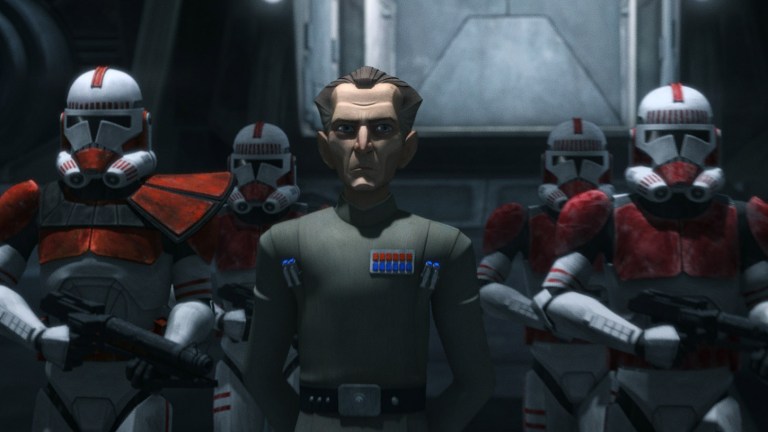What Star Wars: The Bad Batch Reveals About the Rise of the Empire
Head writer Jennifer Corbett and producer Brad Rau walk us through the rise of the Empire in Star Wars: The Bad Batch.

Sometimes it seems like every inch of territory in the Star Wars galaxy has been explored. From the fate of the Jedi after Order 66 to every minute detail of the Galactic Civil War, the franchise has always been interested in tracing and expanding its own history.
That tradition continues with the new Disney+ animated series The Bad Batch, which explores the lives of clone troopers in the aftermath of the Clone Wars. This dark period of transition from Republic to Empire was previously chronicled in the now non-canon Legends continuity, but now we have a canon interpretation of it that lines up with The Clone Wars (mostly).
The Bad Batch follows a group of clone outcasts who get a first-hand look at what the Clone Army has become during the rise of the Empire. So far, the show has made three main points about this drastic sea change: the transition from the Republic to the Empire was a smooth one (it seemed to happen overnight), it was violent, and it’s left the clones with few choices.
Stream your Star Wars favorites right here!
At this point in the saga, Emperor Palpatine‘s plans have come to fruition. Anakin Skywalker, now Darth Vader, and the clones have helped him exterminate the Jedi who would be the most likely force to stand between him and his grip on the galaxy. The Clone Army, created to fight the mostly-droid forces of the Separatists, is now a weapon to oppress those they’d once sworn to protect. And the Empire can use a bid for peace to restrict criticism of their own coming atrocities. After all, if we’re no longer at war with droids, how bad can the regime that’s installing new ID requirements and on its way to creating the Death Star be?
During a Zoom call, head writer Jennifer Corbett describes the time period in which The Bad Batch is set as a moment of great unrest. “Even though the war’s over, there are going to be groups that aren’t happy with the sudden shift,” she says. (We saw the founder of one of those groups, Saw Gerrera, in the premiere episode.) “Suddenly the Jedi are gone, Emperor Palpatine is in power, and there’s a massive army at his disposal. Putting it in real world terms, there’d be what the Empire would call insurgent groups, and of course the Empire wants to extinguish that in order to expand their control in different systems. Of course, they’re trying not to seem evil in the very beginning but it’s a slow progression to get the galactic dominance that we see in the Original Trilogy.”
That slow progression plays out visually as well as in terms of story. Star Wars has always used a lot of color as motifs, from the red of Sith lightsabers to the earth tones of the heroes. Producer Brad Rau says The Bad Batch uses a desaturated color palette to mark the transition between the twilight of the Republic and the rise of the Empire.
“Seeing the clone troopers now as the bad guys was really interesting,” he says. “We started taking all the color off their uniforms, off their ships, off the tanks, and putting that Imperial cog in there. When you see an Imperial cog on gray, wow! That’s the Empire. We also tweaked the sound of their voices.”
The clone troopers are proud of their role as protectors of the galaxy, but they were also essentially created as the property of the Republic. It’s Emperor Palpatine who secretly introduced this idea, nudging the Jedi and the Senate down a moral path in which they were fine with a perpetual war against a droid army fought by expendable lab-grown soldiers. The Clone Wars has shown some cases of clones questioning why they were created, particularly when Fives discovered the secret plans for Order 66. Needless to say, not everyone in the Republic treated clones like they were people. But under the Empire, The Bad Batch creators say, things are about to get even worse.
Corbett sees the attitude toward the clones from the Republic to the Empire as very different. “The Republic allowed the clone troopers to have names and embraced them having opinions, where once Order 66 happens and the Empire comes over, as Brad was saying, their armor color is completely bleached and they’re a number. In worse cases, they’re less than a number. The wild card is the Batch. They never fit in with the Republic and definitely not with this Empire!”
While the Bad Batch, also known by their official military designation as Clone Force 99, escape the transition relatively unscathed due to their genetic modifications, the galaxy is in turmoil all around them. The first episode of the season shows freedom fighter Saw Gerrera well on his way to becoming the leader of a faction in rebellion against the Empire. Meanwhile, the Imperials argue that any rebellion is an attempt to prolong the war instead of end it.
Palpatine’s long-term plans touch almost every era of the Star Wars saga. They span from the Republic commissioning the Clone Army in the first place to some clones joining the Rebellion against the Empire. And the era of The Bad Batch shows the myriad ways in which people have to scramble to survive it.

